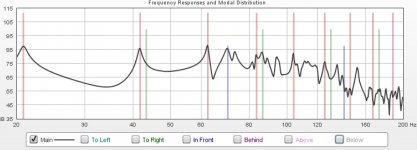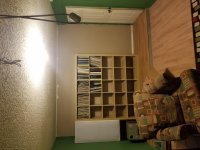The quote and linked paper by Earl Geddes describes a 'first mode' region. What are first, second and third modes -- and how do we determine their frequencies in our small rooms?
"a) Point 1 implies that there are basically two significant regions at LFs in a small room. The first is what I will call the “first mode” region. Basically nothing is going to affect this mode except for damping, and its darn hard to get any damping in the room at these frequencies. This region also contains the oft mis‐understood “pressure mode” (more on that later) and will go up to about the second or sometimes the third mode. From my experience no amount of source moving or numbers of source will have any effect on these (1,2 or maybe 3) modes. EQ is always required to tame these modes if in fact your system goes low enough to excite them (but they are very easy to excite). These modes are also the reason that a sub can excite a room well below its actual free field LF cutoff point and why I don’t pay a whole lot of attention to how low a sub goes in free space."
http://www.gedlee.com/Papers/multiple subs.pdf
"a) Point 1 implies that there are basically two significant regions at LFs in a small room. The first is what I will call the “first mode” region. Basically nothing is going to affect this mode except for damping, and its darn hard to get any damping in the room at these frequencies. This region also contains the oft mis‐understood “pressure mode” (more on that later) and will go up to about the second or sometimes the third mode. From my experience no amount of source moving or numbers of source will have any effect on these (1,2 or maybe 3) modes. EQ is always required to tame these modes if in fact your system goes low enough to excite them (but they are very easy to excite). These modes are also the reason that a sub can excite a room well below its actual free field LF cutoff point and why I don’t pay a whole lot of attention to how low a sub goes in free space."
http://www.gedlee.com/Papers/multiple subs.pdf
Geddes said room treatment would work but it's difficult. If I understand Geddes correctly, he'd take one of your four subs and dedicate it to the first mode region and equalize it for that region. He suggested locating it in a corner where it "sees" all the modes. Then he'd use your other three subs to address the higher modal bass region.
Todd Welti of Harman talks about how to physically locate multi-subs in this paper:
https://www.harman.com/sites/default/files/multsubs_0.pdf
Welti talks about how to optimize equalization of multi-subs in this paper.
https://pdfs.semanticscholar.org/00da/51387c572cfd27c0256cb15e44e976a1a72e.pdf
Todd Welti of Harman talks about how to physically locate multi-subs in this paper:
https://www.harman.com/sites/default/files/multsubs_0.pdf
Welti talks about how to optimize equalization of multi-subs in this paper.
https://pdfs.semanticscholar.org/00da/51387c572cfd27c0256cb15e44e976a1a72e.pdf
Sound quality has been all down hill since folks stopped using wall to wall carpet with felt underlayer.
Maybe I should stop buying cheap tape measures, but I've never gotten much help for my rooms from those apps that predict eigentones.
Whole other matter in terms of where the speakers are in your room and where your chair is. That can be quite different than the scary plots (or more scary sound, depends).
B.
Maybe I should stop buying cheap tape measures, but I've never gotten much help for my rooms from those apps that predict eigentones.
Whole other matter in terms of where the speakers are in your room and where your chair is. That can be quite different than the scary plots (or more scary sound, depends).
B.
So many ways to approach this and each room and situation is different. EQ, traps, multi sub. Maybe a little of each. NO solution is perfect. You can get close building a HUGE room from scratch, float floor, no parallel surfaces, huge bass trap, but most of us. I personally think most guys would seriously benefit with superchunks like you made DJN. This will _tame_ the modes to a degree. From here, you can do like I plan to fool with and built limp mass absorbers tuned to the worst offenders. That being said, I think getting the RT60 of the room down is first priority. Cracks me up to see $20k esotoric systems parked in a loft...
So many ways to approach this and each room and situation is different.
If I understand Geddes with regard to room modes, each room is the same in how you approach the modal region. The one exception is if you have a room in which one dimension is twice as long as the other dimensions. In that case the room behaves like a transmission line. The big difference between our rooms is size in volume, but the behavior in the modal region is the same.
When it comes to typical parallel walls in most homes he recommends treatment on one of the two opposing walls/ceiling or floor.
Geddes is an expert in low frequency room modes. It was the subject of his PhD dissertation at Penn State. Todd Welti is another expert who, as far as I know, does not contradict Geddes on any points regarding small room modal behavior.
On the specific subject of low frequency behavior in small rooms, it's a good idea to pay close attention to what Geddes says and follow his advice. That's why I usually say, "If I understand Geddes." Because if I failed to understand what Geddes meant then I want to be able to adjust my thinking on the topic to match his.
It becomes much simpler if good bass is only required over a small area and your listening position is flexible.
Good point. Mains would be a lot easier in that case too.
- Status
- This old topic is closed. If you want to reopen this topic, contact a moderator using the "Report Post" button.
- Home
- Loudspeakers
- Subwoofers
- Geddes - First Mode region?

